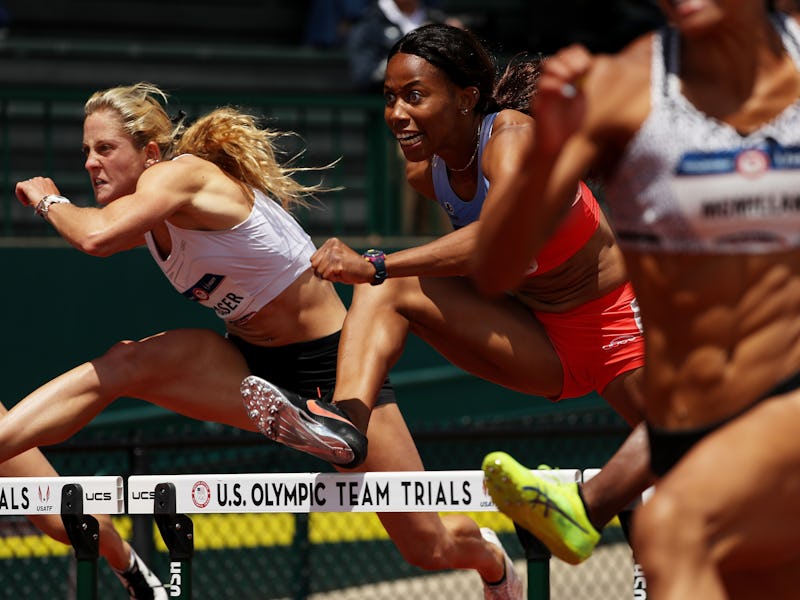How Rio's Climate Will Impact Olympic Running Records
Sprinters like it hot.

World — and Olympic — records have been falling left and right in the Rio de Janeiro Games, and it’s fair to expect that track and field will be a ripe spot for more smashing records.
But a surprising number of factors impact a race that have absolutely nothing to do with an athlete’s abilities or training: track surface, running shoes, starting blocks … and weather.
Here’s how Rio’s tropical climate will influence the runners, from the 100 meter to the marathon.
Temperature
Hot weather is a problem for endurance runners. The ideal race temperature will depend on a lot of things, but one analysis of data from nearly two million marathoners pegs it at between about 40 and 50 degrees Fahrenheit. It’s wintertime in Rio right now, so temperatures aren’t expected to be scorching, but it’s still a pretty hot place. The 5:30 a.m. start times for the races (men this Sunday, women next Sunday) will help, but expect temperatures at least in the 70s, which will put a damper on record-shattering hopes. The Olympics so far have also been bright and sunny, which is great for spectators but hard on endurance runners. Sunny hot weather affects performance more than heat on its own.
Usain Bolt of Jamaica runs to win the 'Mano a Mano' Men's 100m challenge at Copacabana beach on August 17, 2014 in Rio de Janeiro, Brazil.
The opposite is true for sprinters. Hot weather actually improves performance, because warm air is lighter and exerts less drag on the runners. Sprinters don’t have to worry about overheating in a 10-second race, but overcoming wind resistance costs 100-meter athletes like Usain Bolt more that 90 percent of total energy expended. A 36-degree rise in temperature relieves air pressure almost as much as gaining 2,000 feet of altitude, and that makes a big difference in a race that’s decided by hundredths of seconds.
Humidity
The reason humid air feels hotter than dry air is that it’s harder for your sweat to evaporate if the atmosphere around you is already full of moisture. That means marathoners have to expend more energy staying cool, which leaves less to propel themselves forward. Rio’s tropical climate and seaside location could add an extra burden for endurance athletes.
Surprisingly, humid air is actually less dense than dry air. This is because water vapor is lighter than nitrogen and oxygen, the other primary components of the atmosphere. This is why clouds form high in the sky before condensing and raining down. Since the main goal of sprinters is to overcome drag, they actually prefer wet, humid air.
Desiree Linden finishes second in the U.S. Olympic Team Trials Women's Marathon on February 13, 2016 in Los Angeles, California.
Elevation
Finally, one for the marathoners: At lower elevations, the air is thicker, which makes more oxygen available to the athletes. In endurance races, runners don’t need to overcome drag so much as the ability of their bodies to supply enough oxygen to their muscles to keep going. So for them, thick air is a good thing. This is an additional reason why heat and humidity are bad, since both of these thin out the air. But in terms of elevation, Rio is hard to beat. Runners often train at high elevations, preparing their bodies to use oxygen efficiently so that running in thicker air is a relative breeze. With this year’s marathon route running right along the ocean, at least these athletes will have low elevation in their favor.
Thick air, again, is bad for sprinting. Usain Bolt might love the heat and humidity, but Rio’s elevation won’t be working in his favor.
Wind
The marathon course isn’t a straight line; it winds along the beach in one direction and then back the other way. Obviously, it would be great for the marathoners to have the wind at their backs the whole way, but barring exceptional circumstances that’s unlikely to happen. Really, their best hope is calm or near-calm, though it’s hard to say at this point how that will pan out. Rowing races were cancelled this week due to intense stormy weather, and the marathon’s oceanside route will leave them particularly exposed if the wind whips up.
For sprinters, a small tailwind can make a huge difference. It’s such a significant advantage that records don’t count if there’s a tailwind of two meters per second (about 4.5 miles per hour) or more. By one estimate, Bolt would have run his 9.58 record 100-meter race 0.12 seconds faster if his tailwind, estimated at 0.9 meters per second, had been upped to the legal limit. Obviously, they’ll be looking for winds, in the right direction, that flirt with that speed but don’t touch it. How that shapes up is up to the weather gods, and they’re a fickle bunch.